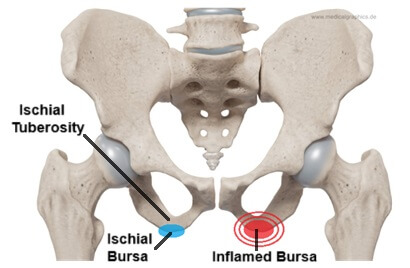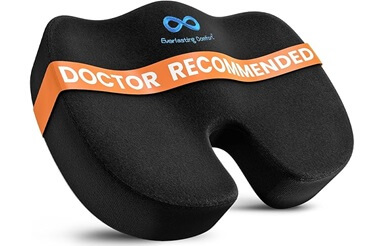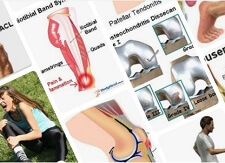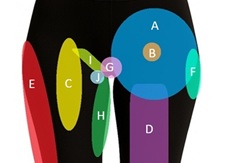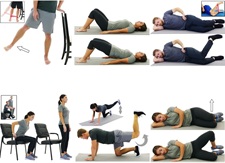- Home
- Hip Pain Diagnosis
- Hip Bursitis
- Ischial Bursitis
Ischial Bursitis
Written By: Chloe Wilson, BSc(Hons) Physiotherapy
Reviewed by: KPE Medical Review Board
Ischial bursitis, aka Weaver’s Bottom, is a common cause of buttock pain when sitting down on hard chairs.
Your sitting bones are cushioned by small, fluid filled sacs, called the ischial bursa. Repetitive pressure or friction on the bursa leads to irritation and inflammation, resulting in ischial bursitis.
A number of things can cause ischial tuberosity bursitis including repetitive activities e.g. running or cycling, a fall or sitting for long periods.
In most cases, ischial bursitis will settle down within a few weeks with a combination of rest, physical therapy, medication and exercises but more persistent cases may require steroid injections or surgery.
Here we look at what ischial bursitis is, the common causes and symptoms, how it is diagnosed, the best treatment options and how to prevent it.
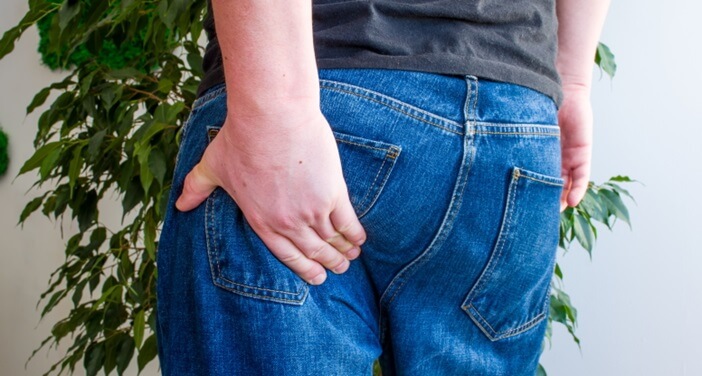
What is Ischial Bursitis?
Ischial bursitis is a type of hip bursitis that occurs when the bursa that sits over the bony prominence at the bottom of the pelvis becomes inflamed, usually due to irritation or overuse.
The ischial bursa is a cushion-like sac that helps reduce friction between the ischial bone and surrounding tissues e.g. muscles and tendons, making it easier to move your hips. It sits directly between the ischial tuberosity and the gluteus maximus tendon.
When inflamed, it can cause pain and tenderness in the lower buttock region, particularly when pressure is applied during activities like sitting.
Ischial bursitis is often linked to occupations or activities that require prolonged sitting, which puts pressure on the ischial bursa. It is also common in athletes who engage in sports that involve repetitive hip movements, such as running, cycling, and rowing.
While the pain is usually localized to the lower buttock, it can sometimes radiate down the back of the leg, mimicking symptoms of sciatica or knee problems.
Ischial bursitis is also known as Weaver’s Bottom, Tailor’s Bottom, ischiogluteal bursitis or ischial tuberosity bursitis – they all refer to the same condition.
Causes of Ischial Bursitis
Several factors can contribute to the development of ischial bursitis, including:
- Prolonged Sitting: Sitting for long periods, especially on hard or uncomfortable surfaces, places constant pressure on the ischial bursa. This is common among people with sedentary jobs or those who travel frequently, as well as cyclists and rowers who sit for extended periods while engaging in repetitive lower-body movements.
- Repetitive Activities: Activities that involve repeated flexing and extending of the hips — such as running, cycling, and rowing — can cause friction between the ischial bone and the bursa. Over time, this can lead to irritation and inflammation of the bursa.
- Trauma or Injury: A direct fall onto the buttocks or repeated pressure from activities like weightlifting or jumping can irritate the bursa and lead to bursitis. Trauma can cause bruising or irritation of the bursa, triggering inflammation. Hamstring injuries can also increase the risk of developing Weaver’s bottom.
- Sudden Increase in Activity: A sudden increase in physical activity without proper conditioning can overload the hip muscles and bursa, triggering inflammation e.g. a new running routine or increasing the intensity or duration of workouts.
- Tight Hamstrings: Tight hamstring muscles, which attach to the ischial tuberosity, can increase tension on the ischial bursa, leading to inflammation. Runners and athletes with tight hamstrings are particularly prone to this.
- Underlying Conditions: Certain conditions like osteoarthritis or rheumatoid arthritis can increase the likelihood of developing bursitis due to the increased strain on the joints and surrounding tissues.
Ischial Bursitis Symptoms
The primary symptom of ischial bursitis is pain in the lower buttock, which can range from mild discomfort to severe, sharp pain, depending on the extent of the inflammation. The most common ischial bursitis symptoms include:
- Pain in the Lower Buttock: Pain is usually felt at the base of the pelvis, right underneath the sitting bones. In some cases, pain may radiate down the back of the thigh and there may also be some pain behind the knee.
- Tenderness or Swelling: The area around the ischial tuberosity may be tender to the touch, and in some cases, swelling can sometimes occur.
- Discomfort with Movement: Activities that involve hip movement, such as walking, running, climbing stairs, or stretching the hamstrings, may increase the pain as these activities engage the muscles around the ischial bursa.
- Difficulty Sitting: Sitting for prolonged periods can become extremely painful with ischial bursitis and in some cases, it may be painful as soon as you sit down, especially if you are sitting on a hard chair. Some people may notice the pain more when they first get up from sitting.
- Reduced Hip Mobility: Hip range of motion may be reduced with weaver’s bottom, particularly hip extension.
- Trouble Sleeping: It may be difficult to get comfortable in bed, or ischial bursitis pain may wake you during the night.
Diagnosis of Ischial Bursitis
To diagnose ischial bursitis, a healthcare provider will take a thorough medical history and perform a physical examination. The examination will involve palpating the ischial area to assess for tenderness, swelling, and pain. You may be asked to perform certain movements to determine whether hip motion increases your discomfort.
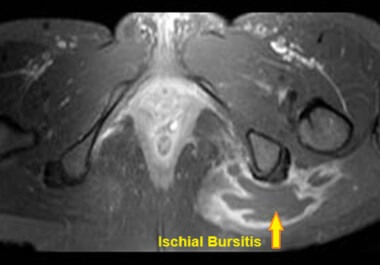
If the diagnosis is unclear or if your doctor wants to rule out other conditions such as sciatica or a hamstring injury, imaging tests may be recommended:
- X-rays can help rule out bone abnormalities, fractures, or arthritis.
- Ultrasound (US) or MRI scans can provide a detailed view of the soft tissues and confirm the presence of bursitis or other soft tissue injuries.
Differential Diagnosis
There are a number of other conditions that cause similar symptoms to ischial bursitis and correct diagnosis is crucial for effective treatment.
Here are some conditions that could be mistaken for Weaver’s Bottom:
1. Nerve Pain

Nerve pain caused by nerve compression or irritation in the lower spine, can produce pain that radiates into the buttock and leg. This is often due to a herniated disc or spinal degeneration and is often referred to as sciatica.
The pain may feel similar to ischial bursitis, but lumbar radiculopathy typically involves neurological symptoms like numbness, tingling, a sharp, shooting pain or muscle weakness in the legs, which are not characteristic of bursitis.
You can find out loads more about nerve pain in the leg on our sister site.
2. Hamstring Tendinopathy
Hamstring tendinitis is an overuse injury that affects the hamstring tendons where they attach to the ischial tuberosity. This condition causes pain in the same region as ischial bursitis but is more often associated with tightness or discomfort during activities like running, bending, or stretching the leg.
Ischial bursitis pain tends to worsen when sitting, whereas hamstring tendinopathy pain may be more noticeable during or after physical activity.
3. Piriformis Syndrome
Piriformis syndrome involves irritation or compression of the sciatic nerve by the piriformis muscle (located deep in the buttock). It often causes pain, numbness, or tingling in the buttock and can radiate down the leg, similar to sciatica.
However, piriformis syndrome is related to nerve entrapment, whereas ischial bursitis is caused by inflammation of the bursa. A key distinguishing factor is that piriformis syndrome may lead to leg weakness, which is not typical in bursitis.
4. Gluteal Tendinopathy
This condition involves inflammation or degeneration of the tendons that attach the gluteal muscles to the pelvis. Gluteal tendinopathy can cause pain in the buttock, particularly when walking, standing, or moving the hip joint.
However, this pain is usually felt higher on the outer side of the hip rather than deep in the buttock near the ischial tuberosity.
5. Trochanteric Bursitis
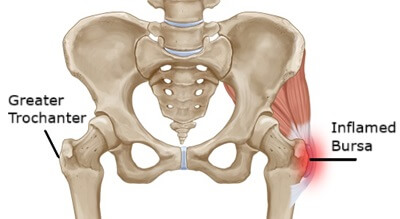
Though similar in name, trochanteric bursitis affects a different part of the hip.
It causes inflammation of the bursa near the greater trochanter, on the outside of the hip, leading to outer hip pain. This pain is usually felt when lying on the affected side or during activities that involve hip movement, such as walking.
Trochanteric bursitis pain is more lateral, while ischial bursitis pain is focused in the lower buttock.
6. Hip Joint Problems
Osteoarthritis in the hip joint can cause pain in the buttock, groin, or thigh similar to weaver’s bottom. While bursitis often results in localized pain at the ischial tuberosity, osteoarthritis is associated with joint stiffness, reduced range of motion, and a deep, aching pain that worsens with activity.
Hip impingement is a condition where excess bone forms on the joint which causes friction in the hip joint. This results in a deep, aching hip pain which may radiate to the buttock.
An X-ray can help differentiate between the two by showing joint space narrowing or bone changes.
#CommissionsEarned from Amazon on qualifying purchases
Ischial Bursitis Treatment
Treatment for ischial bursitis focuses on reducing inflammation, relieving pain, and preventing further irritation of the bursa. Common ischial bursitis treatments include:
1. Rest and Activity Modification
Avoid activities that aggravate the symptoms, such as sitting for prolonged periods or engaging in repetitive hip movements. Resting the affected area gives the bursa time to heal and reduces inflammation and is one of the most important ischial bursitis treatments.
2. Ice Therapy
Applying an ice pack to the affected area for 15-20 minutes several times a day can help reduce inflammation and alleviate pain. You can find out more about how to use ice safely and effectively in the ice treatment section.
3. Medication
Over-the-counter non-steroidal anti-inflammatory drug (NSAIDs) like ibuprofen/Advil or naproxen can help reduce pain and swelling. In more severe cases, your doctor may prescribe stronger anti-inflammatory medications.
4. Physical Therapy
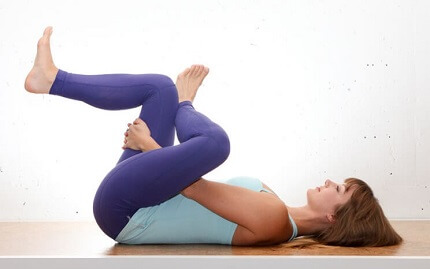
A physical therapist will recommend ischial bursitis exercises and stretches to improve flexibility in the hamstrings, strengthen surrounding muscles, and reduce strain on the bursa.
Hamstring stretches and hip strengthening exercises are often included in the rehabilitation program to relieve pressure on the ischial bursa, helping to prevent recurrence. Glute strengthening exercises are particularly effective. You may also learn techniques to improve posture and reduce strain during sitting or physical activity.
They may also use electrotherapy treatment e.g. ultrasound or pulsed shortwave diathermy to reduce inflammation and promote healing.
5. Corticosteroid Injections
In cases where pain persists despite conservative treatment, a corticosteroid injection directly into the bursa may be recommended. Ischial bursitis injections can provide significant relief by reducing inflammation and pain, though repeated injections should be avoided to prevent tissue damage.
6. Padding and Cushioning
Using a padded cushion or soft seat can reduce pressure on the ischial bursa when sitting, helping to alleviate pain and prevent further irritation.
You can also get specially designed ischial bursitis cushions that can really help if you have to sit a lot during the day. They are super comfy and really do make a big difference for anyone suffering from Weaver's bottom.
7. Surgery
Surgery is rarely needed for ischial bursitis but may be considered if conservative treatments fail. A bursectomy (removal of the inflamed bursa) may be performed to relieve chronic symptoms.
Prevention of Ischial Bursitis
To reduce your risk of developing ischial bursitis or prevent a recurrence, consider these strategies:
- Avoid Prolonged Sitting: If you have a sedentary job or spend long periods sitting, take frequent breaks to stand, walk, and stretch. Using a soft chair or ischial bursitis cushion can also help relieve pressure on the ischial bursa and is one of the best ways to reduce the risk of developing ischial bursitis.
- Stretch and Strengthen: Stretching and hip strengthening exercises help to reduce tension around the ischial bursa. Hamstring stretches, glutes strengthening and hamstring strengthening exercises are particularly useful for reducing strain on the bursa.
- Warm-Up and Cool Down: Always warm up before exercise and stretch afterward to maintain flexibility and to help protect the muscles around the hips and pelvis.
- Gradual Increase in Activity: If you're starting a new exercise routine, gradually increase the intensity and duration of activities to avoid overloading the muscles and bursa.
- Proper Posture: Pay attention to your posture while sitting, standing, or performing physical activities to reduce strain on the lower back and hips.
Ischial Bursitis FAQs
1. What Does Ischial Bursitis Feel Like?
1. What Does Ischial Bursitis Feel Like?
Ischial bursitis typically causes a deep, aching pain in the lower buttock, especially when sitting on hard surfaces. The pain may worsen with prolonged sitting or activities like running and can sometimes radiate down the back of the leg.
2. How Do You Get Rid Of Ischial Bursitis?
2. How Do You Get Rid Of Ischial Bursitis?
Ischial bursitis treatment involves rest, avoiding aggravating activities, using cushions for sitting, and applying ice to reduce inflammation. Over-the-counter anti-inflammatory medications and physical therapy with targeted stretches can also help. In severe cases, corticosteroid ischial bursitis injections may be recommended.
3. How Long Does Ischial Bursitis Last?
3. How Long Does Ischial Bursitis Last?
With proper treatment, most cases of ischial bursitis improve within a few weeks to a few months. Chronic cases may take longer and require more intensive management.
4. What Can Be Mistaken For Ischial Bursitis?
4. What Can Be Mistaken For Ischial Bursitis?
Conditions such as sciatica, hamstring tendinopathy, piriformis syndrome, hip impingement, iliopsoas bursitis and trochanteric bursitis can cause similar pain in the buttock and may be mistaken for ischial bursitis.
5. What Is The Best Exercise For Ischial Bursitis?
5. What Is The Best Exercise For Ischial Bursitis?
Gentle stretching exercises that target the hamstrings and gluteal muscles can relieve tension around the ischial bursa. Hip strengthening exercises, such as bridges or clamshells, are also helpful for supporting the area and preventing further irritation.
6. Does Sitting Make Ischial Bursitis Worse?
6. Does Sitting Make Ischial Bursitis Worse?
Yes, sitting - especially on hard surfaces - can put pressure on the ischial bursa and worsen the pain. Using a cushion or taking frequent breaks to stand and stretch can help alleviate discomfort.
7. Are There Any Ischial Bursitis Exercises To Avoid?
7. Are There Any Ischial Bursitis Exercises To Avoid?
Yes, avoid high-impact activities like running and jumping, deep squats and lunges, and prolonged sitting exercises like cycling or rowing. Hamstring-heavy exercises such as deadlifts or hamstring curls should also be minimized, as they can increase strain on the ischial bursa.
Summary
Ischial bursitis, aka Weaver’s Bottom, is a painful condition caused by inflammation of the bursa in the lower buttocks. It commonly results from prolonged sitting, repetitive movements, or injury. With appropriate treatment - including rest, ice, physical therapy, hip strengthening exercises, and anti-inflammatory medications - most cases of ischial bursitis improve over time.
By incorporating preventive measures like proper stretching and avoiding prolonged sitting, you can reduce your risk of developing or aggravating this condition. If your symptoms persist despite treatment, consult a healthcare professional for further evaluation and guidance.
There are two other types of hip bursitis:
- Trochanteric Bursitis: on the outer hip
- Iliopsoas Bursitis: at the front of the hip
You may also be interested in the following articles:
- Top Of Thigh Pain
- Hip Impingement
- Hip Labral Tear
- Hip Strengthening Exercises
- Glute Stretches
- Glute Strengthening Exercises
Related Articles
Knee Pain Diagnosis
March 27, 2025
Hip Pain Diagnosis
September 16, 2025
Hip Strengthening
September 24, 2025
Medical & Scientific References
- Ischial Bursitis. National Library Of Medicine
- Typical MRI Findings Of Bilateral Ischial Bursitis: Bilateral Weaver’s Bottom. British Medical Journal Case Reports
- Ischial Bursitis. ResearchGate
Last Updated: September 8th, 2025
Next Review Due: September 8th, 2027
